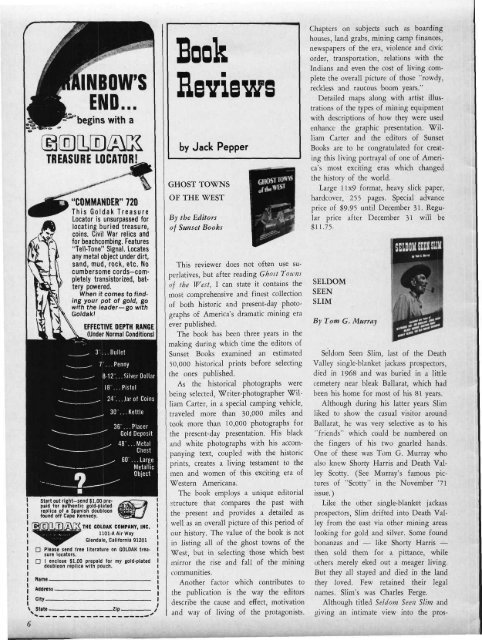DECEMBER, 1971 50c - Desert Magazine of the Southwest
DECEMBER, 1971 50c - Desert Magazine of the Southwest
DECEMBER, 1971 50c - Desert Magazine of the Southwest
Create successful ePaper yourself
Turn your PDF publications into a flip-book with our unique Google optimized e-Paper software.
INBOW'S<br />
END...<br />
'begins with a<br />
TREASURE LOCATOR!<br />
"COMMANDER" 720<br />
This Go I dak Treasure<br />
Locator is unsurpassed for<br />
locating buried treasure,<br />
coins. Civil War relics and<br />
for beachcombing. Features<br />
"Tell-Tone" Signal. Locates<br />
any metal object under dirt,<br />
sand, mud, rock, etc. No<br />
cumbersome cords-cornpletely<br />
transistorized, battery<br />
powered.<br />
When it comes to finding<br />
your pot <strong>of</strong> gold, go<br />
with <strong>the</strong> leader—go with<br />
Goldak!<br />
Start out right-send $1.00 prepaid<br />
for au<strong>the</strong>ntic gold-plated<br />
replica <strong>of</strong> a Spanish doubloon<br />
found <strong>of</strong>f Cape Kennedy.<br />
EFFECTIVE DEPTH RANGE<br />
(Under Normal Conditions<br />
THE GOLDAK COMPANY, INC.<br />
1101-AAirWay<br />
Glendale, California 91201<br />
• Please send free literature on GOLDAK treasure<br />
locators.<br />
Q I enclose $1.00 prepaid for my gold-plated<br />
doubloon replica with pouch.<br />
Name —<br />
Address -<br />
City<br />
State- -Zip.<br />
Book<br />
Reviews<br />
by Jack Pepper<br />
GHOST TOWNS<br />
OF THE WEST<br />
By <strong>the</strong> Editors<br />
<strong>of</strong> Sunset Books<br />
This reviewer does not <strong>of</strong>ten use superlatives,<br />
but after reading Ghost Towns<br />
<strong>of</strong> she West, I can state it contains <strong>the</strong><br />
most comprehensive and finest collection<br />
<strong>of</strong> both historic and present-day photographs<br />
<strong>of</strong> America's dramatic mining era<br />
ever published.<br />
The book has been three years in <strong>the</strong><br />
making during which time <strong>the</strong> editors <strong>of</strong><br />
Sunset Books examined an estimated<br />
50,000 historical prints before selecting<br />
<strong>the</strong> ones published.<br />
As <strong>the</strong> historical photographs were<br />
being selected, Writer-photographer William<br />
Carter, in a special camping vehicle,<br />
traveled more than 30,000 miles and<br />
took more than 10,000 photographs for<br />
<strong>the</strong> present-day presentation. His black<br />
and white photographs with his accompanying<br />
text, coupled with <strong>the</strong> historic<br />
prints, creates a living testament to <strong>the</strong><br />
men and women <strong>of</strong> this exciting era <strong>of</strong><br />
Western Americana.<br />
The book employs a unique editorial<br />
structure that compares <strong>the</strong> past with<br />
<strong>the</strong> present and provides a detailed as<br />
well as an overall picture <strong>of</strong> this period <strong>of</strong><br />
our history. The value <strong>of</strong> <strong>the</strong> book is not<br />
in listing all <strong>of</strong> <strong>the</strong> ghost towns <strong>of</strong> <strong>the</strong><br />
West, but in selecting those which best<br />
mirror <strong>the</strong> rise and fall <strong>of</strong> <strong>the</strong> mining<br />
communities.<br />
Ano<strong>the</strong>r factor which contributes to<br />
<strong>the</strong> publication is <strong>the</strong> way <strong>the</strong> editors<br />
describe <strong>the</strong> cause and effect, motivation<br />
and way <strong>of</strong> living <strong>of</strong> <strong>the</strong> protagonists.<br />
Chapters on subjects such as boarding<br />
houses, land grabs, mining camp finances,<br />
newspapers <strong>of</strong> <strong>the</strong> era, violence and civic<br />
order, transportation, relations with <strong>the</strong><br />
Indians and even <strong>the</strong> cost <strong>of</strong> living complete<br />
<strong>the</strong> overall picture <strong>of</strong> those "rowdy,<br />
reckless and raucous boom years."<br />
Detailed maps along with artist illustrations<br />
<strong>of</strong> <strong>the</strong> types <strong>of</strong> mining equipment<br />
with descriptions <strong>of</strong> how <strong>the</strong>y were used<br />
enhance <strong>the</strong> graphic presentation. William<br />
Carter and <strong>the</strong> editors <strong>of</strong> Sunset<br />
Books are to be congratulated for creating<br />
this living portrayal <strong>of</strong> one <strong>of</strong> America's<br />
most exciting eras which changed<br />
<strong>the</strong> history <strong>of</strong> <strong>the</strong> world.<br />
Large 11x9 format, heavy slick paper,<br />
hardcover, 255 pages. Special advance<br />
price <strong>of</strong> $9.95 until December 31. Regular<br />
price after December 31 will be<br />
$11.75.<br />
SELDOM<br />
SEEN<br />
SLIM<br />
By Tom G. Murray<br />
Seldom Seen Slim, last <strong>of</strong> <strong>the</strong> Death<br />
Valley single-blanket jackass prospectors,<br />
died in 1968 and was buried in a little<br />
cemetery near bleak Ballarat, which had<br />
been his home for most <strong>of</strong> his 81 years.<br />
Although during his latter years Slim<br />
liked to show <strong>the</strong> casual visitor around<br />
Ballarat, he was very selective as to his<br />
"friends" which could be numbered on<br />
<strong>the</strong> fingers <strong>of</strong> his two gnarled hands.<br />
One <strong>of</strong> <strong>the</strong>se was Tom G. Murray who<br />
also knew Shorty Harris and Death Valley<br />
Scotty. (See Murray's famous pictures<br />
<strong>of</strong> "Scotty" in <strong>the</strong> November '71<br />
issue.)<br />
Like <strong>the</strong> o<strong>the</strong>r single-blanket jackass<br />
prospectors, Slim drifted into Death Valley<br />
from <strong>the</strong> east via o<strong>the</strong>r mining areas<br />
looking for gold and silver. Some found<br />
bonanzas and - - like Shorty Harris -<br />
<strong>the</strong>n sold <strong>the</strong>m for a pittance, while<br />
o<strong>the</strong>rs merely eked out a meager living.<br />
But <strong>the</strong>y all stayed and died in <strong>the</strong> land<br />
<strong>the</strong>y loved. Few retained <strong>the</strong>ir legal<br />
names. Slim's was Charles Ferge.<br />
Although titled Seldom Seen Slim and<br />
giving an intimate view into <strong>the</strong> pros-

















